- Home
- Gary Vaynerchuk
Jab, Jab, Jab, Right Hook Page 10
Jab, Jab, Jab, Right Hook Read online
Page 10
PROMOTED TWEETS
Creating context around trending hashtags only requires an investment of time, but buying a promoted tweet can be a great investment, too. On the same day that 30 Rock trended, so did #GoRed, because the American Heart Association sponsored National Wear Red Day to raise awareness around the fight against heart disease. Above the hashtag, there was an ad for Tide laundry detergent saying, “It’s crazy how Tide gets rid of tough stains, but what about the stains you want to save?” Aha. Color. With #GoRed, Tide saw an opportunity to bring attention to its color-saving capabilities. That’s a clever use of a hashtag. It was micro, it was inexpensive, and it made an impression. Think about that. Consumers are spending 10 percent of their time on mobile and there is no more mobile platform than Twitter. Yet for all the consumer attention Twitter attracts, placing an ad there still only costs lunch money compared with the price of a television ad. That was a smart use of Tide’s media dollars. So many companies could have taken advantage of that opportunity. Where was Crayola? What about Target, with its big red bull’s-eye? Or Red Envelope?
USING TRENDS TO THROW RIGHT HOOKS
Trending topics can be names or current events, but they can also be memes—words and phrases that have gone viral in the public sphere. These are low-hanging fruit, perfect storytelling fodder for any brand or business, especially local companies looking for a fun, creative way to differentiate themselves from their competitor.
On one of the days I was working on this chapter, the fifth-trending topic on Twitter was #sometimesyouhaveto. You can’t get a better lead-in for a right hook. Literally anyone could adapt it to his or her needs:
A cheese shop could say, “#Sometimesyouhaveto eat a slice of Cabot clothbound Cheddar.”
A fitness club could say, “#Sometimesyouhaveto use the sauna as incentive.”
A lawyer could say, “#Sometimesyouhaveto call a lawyer to make your problem go away.”
Taking advantage of hashtags is a great way for small businesses to get attention. That trending hashtag is getting clicked by tens of thousands of people. There is no reason why someone won’t spot your version, like it, and go to your profile page to see what else you have to say. Once he’s there, he can see the whole story you’ve been telling about yourself with your steady stream of jabs and occasional right hooks. He decides to follow you. Maybe he needs a lawyer. Maybe he has reason to believe that one day he will need a lawyer. Regardless, you are now that much closer to gaining a new customer when the time is right.
It could happen for a DJ in Miami named DJ Monte Carlo. While I was clicking on this trending hashtag, I spotted his tweet: “#SometimesYouHaveTo forgive those who hurt you but never forget what it taught you.”
I liked that. It hit my emotional center. I decided to follow him, and he wound up in my Twitter stream, where my colleague Sam could see it. I’m not a big clubgoer, but Sam is. Maybe Sam decided to follow DJ Monte Carlo, too. And maybe, in six months, Sam will be scrolling through his Twitter feed and he’ll see Monte Carlo throw a right hook announcing that he’s spinning at a club in New York City that night. And maybe Sam will decide to go, too.
Get it? This is not a far-fetched scenario; it’s how Twitter culture works every day. So get creative, have fun, and start experimenting with creating content on the spot, because the trending topics you see one minute will be gone the next. They have short life spans.
Something else to realize is that just because a topic is not one of the top-ten trends on Twitter doesn’t mean it’s not worth paying attention to. The Twitter demographic skews hip and urban, but it doesn’t represent the only people talking online. You want to pay attention to what the rest of the world is interested in, too. Look for clues on Google trends. It skews young as well, just like all online data, but it reflects a broader population. During the 2013 U.S. Open golf tournament, the hashtag “#usopen” was, unsurprisingly, trending on Twitter. In response, KPMG Mickelson, the “official Twitter account for Phil Mickelson’s hat,” promoted a tweet to followers of the hashtag, suggesting that golf fans honor their dads on Father’s Day by donating to a charitable anti-illiteracy campaign by buying a blue Phil Mickelson hat. KPMG Mickelson didn’t actually use the hashtag “#usopen” (in fact, if they’re not an official event sponsor, their legal department may not have let them use the hashtag) and yet, through strategic sponsoring, they came up as the top result for anyone checking that hashtag. They were smart about the hashtag they did use, too#—fathersday.*
This example shows that KPMG Mickelson did something too many businesses don’t do on Twitter: They listened. It’s extremely hard to create a trending hashtag and bring people to you. It’s far better to listen, find out what’s trending, and bring yourself to the people. In this case, golf fans were already having the conversation. Promoting the tweet ensured that KPMG Mickelson’s message became part of that conversation. It was doubly smart to include it in the Father’s Day stream, as well.
This praise comes with two caveats:
Amazingly, even while KPMG Mickelson correctly joined trending conversations, they also unnecessarily included the hashtag “#PhilsBlueHat” in their tweet. How did their own invented hashtag do? A total of three people used it in the three days following KPMG’s original tweet. That’s embarrassing.
The link in the tweet doesn’t actually take consumers to make a purchase. It goes to KPMG’s Phil’s Blue Hat website, where it takes yet another click to buy the hat. Adding extra steps after a call to action wastes the consumer’s time.
Whether you jab or right hook, marketing moves like that prove that you’re up to date, that you’ve got a sense of humor, and most of all, that you’re paying attention. You’d be amazed at how far that goes when customers are looking for someone with whom to do business.
CHOOSE HASHTAGS CAREFULLY
There’s a skill to choosing hashtags. You can’t just cover all your bases by tacking a bunch of hashtags onto a sentence. They won’t work if they don’t feel native to Twitter and natural to your brand. For example, Twitter is a hotbed of irony, but if your natural tone is generally serious and thoughtful, going ironic with your hashtags or suddenly adopting hipster vocabulary is just going to make you look like a poser. Being cool has nothing to do with age; it has to do with how solid your identity is. Do not pretend to be anyone other than who you are. That said, don’t take yourself too seriously, either. Be human. If you’re not comfortable talking pop culture, find someone in your organization or partner with an agency that is. Whatever you do, however, stay true to yourself. Do not pretend to be cooler than you are. Do not be the guy who hollered out, “Raise the roof!” a year too late. That’s how it sounds when you use hashtags and trending topics as indiscriminate marketing tactics, instead of incorporating select ones into your conversation. Listen. Entertain, through humor or provocation.
Entrepreneurs and small businesses may see the amount of work that has to go into keeping up on Twitter and wonder if they shouldn’t just give up and go home. There’s no way they can compete with larger companies that have extensive budgets and staff. A person has to sleep sometime. Yes, creating real-time micro-content is an enormous job. Yes, start-ups and small businesses will have to be selective about which trends are worth their time and money. But putting your effort into that kind of thinking will do a heck of a lot more for your bottom line than sitting around like a dope waiting for customers to come to you. And it’s way better than tweeting content that no one sees or cares about.
As a small business, you can gain an edge over larger companies when it comes to being nimble and authentic, two imperatives to successful Twitter marketing. Because you haven’t let your personality get squashed by a PR or legal department, you have more freedom to say what you think, to look for humor in unexpected places, and to be self-deprecating. That last one works like a charm. I just admitted in an interview for Inc. magazine that I peed in my bed until I was twelve years old. Can you imagine anyone in a Fortune 500 comp
any getting that personal or irreverent? Neither can I. People love it when you acknowledge your humanity and vulnerability. You may be a lightweight up against a heavyweight, but you can be the lightweight who wakes up at 3 A.M., drinks a few raw eggs, and puts in two hours at the gym before the competition’s alarm clock goes off. People will notice your effort, and it will make a difference.
SCALING THE UNSCALABLE
To see what that kind of effort looks like, take a look at the conversation Levi Lentz had with Green Mountain Coffee (full disclosure: Green Mountain Coffee Roasters is a VaynerMedia client at the time of this book’s publication). Green Mountain Coffee was poking its nose far beyond its comfortable coffee burrow; otherwise it never would have seen Lentz’s tweet. All Lentz tweeted was “ ‘Say Hey’ by Michael Franti is one of my favorite songs.”
To his surprise, he received a reply from the verified Green Mountain Coffee Twitter account, saying, “We love that song! Isn’t it motivational?”
On the surface, there is no connection between the topic of coffee and the bouncy love song Lentz was listening to. Green Mountain’s jab is pure storytelling context—we’re a brand that likes the same music you do. Now, what Lentz didn’t know was that Michael Franti was working on a fair trade campaign with Green Mountain Coffee, so there was, in fact, a reason why Green Mountain was so interested in engaging with his tweet. However, the fact that he wasn’t weirded out by the fact that a brand would contact him to talk about music proves how receptive people are to brands that reach out to consumers.
Coffee was not mentioned until Lentz brought it up, politely telling Green Mountain that he was just learning to like coffee, so he had never tried their products, but that he would definitely do so now. Green Mountain made some inquiries into his coffee tastes and followed up with a few recommendations. The conversation ended with Green Mountain asking Lentz to DM his mailing address so they could send him a Michael Franti CD, just because.
Lentz knew he was being marketed to, but he didn’t care. Out of the blue, a brand had struck up an engaging conversation, given him some information he was looking for, and offered to send him a gift. Of course he wrote about it on his blog. Then he wrote about it again a few days later when he received the CD in the mail, as well as another package containing a handwritten thank-you note for writing about the company on his blog, a coffee mug, and a sample of coffee.
By watching out for opportunities to introduce itself, Green Mountain Coffee garnered extensive earned media and gained a lifelong customer by being personable, charming, generous, and above all, real, with a perfect stranger. As any good matchmaker knows, when two people are reluctant to meet, you sometimes need to find a way to firmly nudge them into the same room so they can realize how compatible they are with one another. For those companies who learn to spin compelling stories from the threads of news and information floating through the Twittersphere, this social media platform is the most indefatigable consumer-to-brand connector that ever existed.
COLOR COMMENTARY
LACOSTE: Interrupting Its Own Conversation
Lacoste is a brand with a tremendous amount of staying power. I loved Lacoste’s alligator on my shirts when I was a little kid, and recently I’ve rediscovered the brand and started wearing it again. Reinventing yourself to your fans is no small feat, so kudos to Lacoste for pulling it off. Unfortunately, that’s the only praise they’re going to get from me, because this is one of the worst examples of a poorly thrown right hook in this book. It’s laughably bad. I know this because I laughed my face off when I saw it.
Treats the consumer like an idiot: In the text, Lacoste asks, “If you could do one thing today, what would it be?” That’s a great way to invite fans to engage. In a parallel universe, fans are posting comments like “Sleep!” “Ride a paddle boat,” “Travel to Mars,” “Promote whirled peas,” and in all likelihood, “Shop!”—which would be an ideal moment for the brand to respond directly to that consumer and build a relationship. It would be a great opportunity for the brand to show off the personality of its fans, which in turn should reflect favorably on its own persona. But in this universe, where someone at Lacoste isn’t thinking, the brand halts the conversation before it even starts by answering its own question. It’s as if Lacoste didn’t trust that its fans would answer the way it wanted them to. Remember, it’s “Give, give, give, give, give . . . ask,” not, “Give, give, give, give, give . . . demand!”
Pointless link: Like Zara on page 52, Lacoste seems to think that its website should be the hub of all its media outreach. If there’s anything that brands should take away from this book, it’s that there is no central hub anymore. Consumers are going to be coming through all kinds of portals, and forcing them to enter through the same door every time is going to make them tire of you. When customers click on this Twitter link, they’re not taken to a special sale or even a promotion for the seasonal trends. They’re just taken straight to the general website, which at the time of this writing features a blank-faced preteen.
Lacoste has more than 370,000 followers at the time of this writing. Of those followers, two saw fit to retweet this post. The link itself only received eighty-eight clicks. That’s as bad as it gets. It’s posts like this that are responsible for all the pointless noise on Twitter that makes it harder for the great content to get noticed. I can’t even bring myself to say, “See you later, alligator,” because if I see more of these kind of tweets later I may abandon the brand altogether.
DUNKIN’ DONUTS: Sweet, but Out of Date
This is a charming, lightweight jab to sell iced coffee. The copy is the appropriate length, the tone is right, and the image is clever. But I have to question why the creatives at Dunkin’ Donuts decided to turn their iced coffee cup into a midcentury relic.
Anachronistic image: They would have come across as a much more modern brand if they had depicted the cup with an iPhone charger coming out of it instead of a two-pronged plug that could belong to an elderly uncle’s bedside table lamp. It’s possible that Dunkin’ Donuts purposely used an old-fashioned plug to speak to the older demographic that frequents its stores, but if that’s the case, they’re speaking the right language in the wrong country, because the demographic that grew up living in two-pronged-plug homes doesn’t have a particularly strong showing on Twitter (three-pronged grounded outlets became a required safety feature for new homes in the early 1960s). If it is possible for “Who is Paul McCartney?” to be a trending topic on Twitter during the 2012 Grammys, then it is equally possible that half the audience that follows Dunkin’ Donuts on Twitter wouldn’t know what the heck that thing is sticking out of the cup.
One more criticism: The tweet is signed “JG.” I understand that Dunkin’ Donuts is trying to humanize their brand, but in my opinion this is the wrong way to do it. You’re putting your business at risk when you let anyone except your logo or brand build equity on these public platforms. What happens when JG moves on to Starbucks or McDonald’s and people start asking, “Hey, where’s JG?” Your brand needs a unified front and voice. This doesn’t mean you don’t appreciate the efforts of the people who work for you; it means that you have to ensure that everyone is working to build up your brand equity, not their own.
ADIDAS: Slam Dunk
This Adidas Originals right hook is tremendous (yeah, the shoes are kind of whack, but . . . ). I love where Adidas went with this for a few reasons.
Cool picture: They used a terrific picture of their product, clean but exploding with vibrant color. It’s the kind of picture that will make a consumer scrolling through their stream stop in his tracks and take the right hook.
Correct tone: The copy is strong and builds up the story. It’s written in the voice of the brand and target demo, even when they hit with the direct right hook, “Get ’em here.” Often brands will write their copy with all the right slang and swag for a strong delivery, but when they go for the formal ask, that right hook, they switch to more formal corporate-speak, “Yo
u can buy them here.” I love how Adidas carried the appropriate tone all the way through the right hook with “Get ’em here.” Then they got right to the point, linking straight to the product page, not their home page or some other secondary page that would have required more hunting and clicking.
You want to be gentle and subtle when you’re jabbing, but when it’s time to ask for business, go for it. Don’t be bashful. Own it.
Good job, Adidas. Very, very, very well executed.
HOLLISTER: Smart Strategy Gone Wrong
This is a really interesting case study because it represents a lot of smart strategy and a lot of awful execution all in one place.
Brave creative: Hollister deserves credit for understanding the power of Internet memes to reach a young demographic. In response to the huge popularity of planking—choosing a random location in which to lie facedown on the ground with your arms at your side—and its little brother, owling—choosing a random location in which to perch like, you guessed it, an owl—Hollister decided to try to spawn a movement toward “guarding”—holding your hands up in front of your eyes like you’re holding binoculars. They went for a big right hook in asking their community to tag and engage with their meme. It’s a bold move, and I love it! The problem is, though, that it’s ridiculously hard for a brand to create a meme. It’s not a particularly practical move, and consumers don’t tend to follow it. In general, brands should be following memes, not creating them. But Hollister tried, which is admirable.

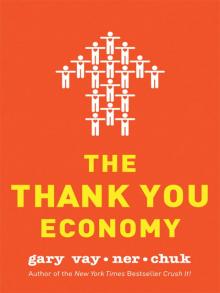 The Thank You Economy
The Thank You Economy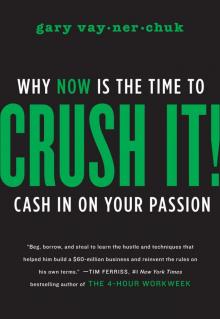 Crush It!
Crush It!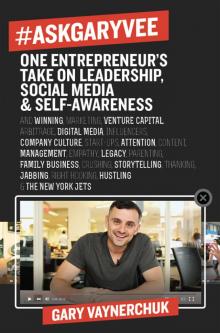 #AskGaryVee
#AskGaryVee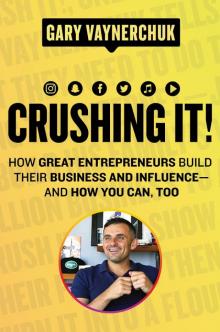 Crushing It! EPB
Crushing It! EPB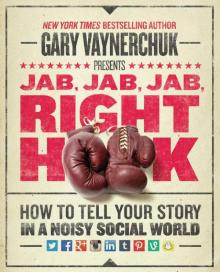 Jab, Jab, Jab, Right Hook
Jab, Jab, Jab, Right Hook